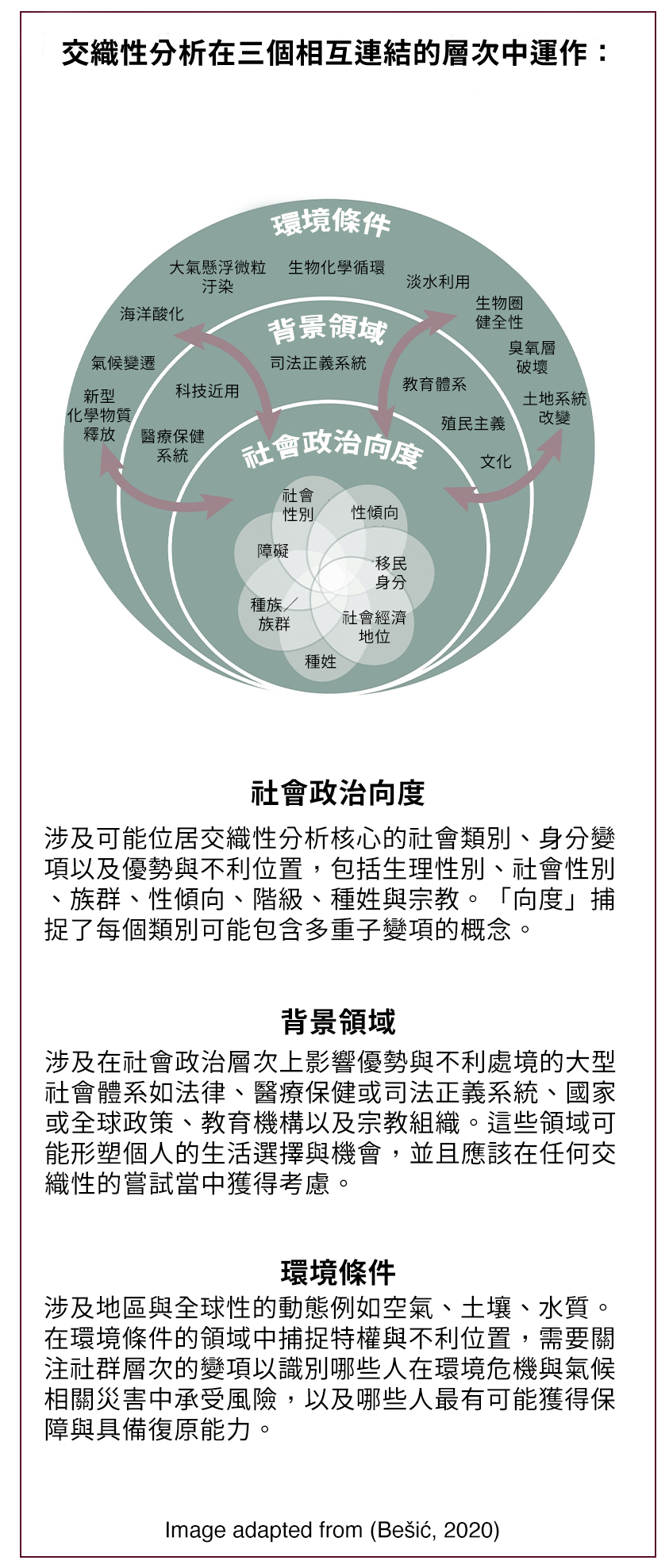
在設定研究的優先順序、發展假設以及生成研究設計時,交織性的研究方式(請見名詞解釋:交織性)是個重要的考量。採取具交織性的研究方法可對於健康成果之變化提供更好的預測,與辨認使用者的需求,最終將能帶來更具包容性的研究與工程解決方案(Nielsen et al., 2025;交織性研究與報告的指南,請參見 Schiebinger et al., 2025)。舉例而言,生理性別、社經狀況、職業的性別區隔,以及語言間的互動會影響著務農者暴露於內分泌干擾物的狀態(請見案例研究:環境化學物質)。研究也展示了交織性研究方法可以如何改善能源效率措施(請見案例研究:智慧能源解決方案),並為管制塑膠污染的政策提供資訊(請見案例研究:永續時尚;Landrigan et al., 2023)。
 辨識問題
辨識問題
交織性研究方法可能適用於任何涉及人類受試者的研究。雖然生理性別與社會性別是需要考慮的重要概念(參見分析生理性別;分析社會性別),但它們塑其他社會政治向度,也受到其他社會政治向度的形塑。形構研究問題的方式將決定分析時需要的交織性向度及因素。
在開始一項研究之前,研究人員應該先進行系統性的文獻搜尋,以辨識出有潛在關聯的因子與分類(Hankivsky, 2014)。交織性分析可考慮三個相互關聯的層面:社會政治向度、背景領域以及環境條件(見方框)。交織性總是考慮兩個或多個社會政治向度的複合影響,例如性別、種族、社會經濟地位、障礙、性傾向、地理位置等(請見案例研究:臉部辨識)。交織性分析通常也會考慮背景領域或權力體系,兩者既以不同方式塑造人們的生活經驗、機會與選擇,也同時受這些因素的形塑。這些可能包括社會、制度與社群層面的情況(例如法律、政策、醫療保健提供者、學校系統、法律執行、宗教機構、犯罪率)(請見案例研究:人口與氣候變遷)。
最後,交織性分析可以檢視環境因素,例如空氣、土壤與水質,以及它們如何導致社會政治層面的不平等。例如,關注環境因素更能理解產品及政策在不同地理位置與社會群體之間的差異影響(請見案例研究:永續時尚;Abi Deivanayagam et al., 2023)。從一開始,研究人員就必須考慮誰的實用知識或經驗與其計畫有所關聯。讓不同的研究對象或潛在的終端使用者參與研究過程(從形構問題到設計研究),可以增強交織性分析的深度並產生更具包容性的解決方案(參見方法:參與式研究和設計)。
設計研究
交織性研究應旨在闡明跨社會政治向度、情境領域與環境條件的相互依存關係。交織性統計方法通常是相乘而非相加的,意味其關注不同但相互依賴的類別和情境的複合效應。確定哪種方法(定性、定量或混合方法)最適合用來檢驗與你的計畫相關之交織性變項。質性方法(例如焦點團體、文本分析、訪談與觀察)可以提供針對塑造人們身分、機會與實踐的複雜因素、過程以及關係網絡的詳細洞察(Collins & Bilge, 2020; Abrahms et al., 2020)。量化方法(例如問卷調查、社群媒體資料、購物與註冊資料)則讓研究人員得以檢視跨群體與子群體的異同之處,也能夠呈現這些異同之處如何依社會脈絡而有變化並隨著時間而改變(Guan et al., 2021; Else-Quest and Hyde, 2016)。在混合方法研究設計中,質化方法可以用於探索有哪些交織性類屬、因子及關係可以在後續的量化分析中進行檢視。然而,質化方法也可以用來深化理解從過往的量化分析中找出的重要互動與關係。舉例而言,一個量化分析或許會呈現出無法以社會性別或社經地位單獨解釋之的意想不到之女男差異,例如高社經地位的女性有著與低社經地位的男性類似的健康狀態(Sen et al., 2010)。在這樣的狀況中,透過質化的後續研究或可協助耙梳出驅使研究所觀察到的差異或相似之處的潛在過程和機制。
必須時時考量研究關注之交織性分類與因子其潛在的動態天性。不同分類與因子的重要性能會依社會脈絡而有差異,也可能隨著時間改變(Hankivsky, 2014)。在量化研究中,這類的變因可使用地理空間分析或縱貫設計進行檢視(Weber et al., 2019; Warner & Brown, 2011)。
最後,使用質性訪談或是問卷調查的研究者應該在展開資料蒐集之前,檢視其問題與類屬是否具有誤導性或刻板的預設。針對目標群體進行廣泛的前導研究與∕或認知訪談將有助提昇研究的信效度,並且讓資料的蒐集更有效率。
蒐集資料
交織性研究需要社會政治向度的詳細資料(例如生理性別、社會性別、階級與種姓等子變項),並仔細考慮構成資料的脈絡領域和環境條件(D'ignazio & Klein, 2023)。例如,將出生時指定的生理性別作為性別認同的替代指標,可能會影響針對少數群體經驗的評估。為了彌補這個缺陷,研究人員可以在問卷調查中採用兩步驟法,分別測量出生時指定的生理性別以及自我描述的性別認同(Magliozzi,2016)。研究人員可能需要策略性地針對特定子群體進行過度抽樣,以確保交織性分析具有足夠的統計檢定力。
在量化研究中,為了讓數據分析有其意義,須計算你的分析中所包含的各個群體所需要之最小樣本數(Rouhani, 2014)。為了讓跨群體之比較及互動分析達到有效的數據檢定力,策略性地針對部份群體做超取樣可能是必要的。同伴推動抽樣法(Heckathorn, 1997)以及時空抽樣法(MacKellar et al., 2007)可用來募集傳統抽樣方法難以接觸到的被邊緣化或是隱藏的群體(Bowleg & Bauer, 2016)。在考慮人與環境的相互作用時,愈來愈多研究結合衛星地球觀測(Satellite Earth Observation)和地理參考(georeferenced)的社會科學資料,以便在需要時提供高解析的人類人口分佈縱貫估計(Bosco et al., 2017; Kugler, et al., 2019)。目前,只有兩個全球資料集,即《世界網格人口》(Gridded Population of the World,GPW)v4 和 WorldPop,提供按生理性別和年齡區分的估計值(Dahmm & Rabiee, 2020)。
在質化研究中,樣本必須要足夠多樣,以捕捉到與研究問題相關之多樣化的交織位置。
資料分析
交織性分析之意圖在於闡明相異但又互依之類屬及因子間的加乘效果。
量化研究應該要超越對於主要影響的添加焦點(例如評估社會性別、種族及性傾向分別的影響),並進一步檢視關注的變因間如何交織(Bauer, 2014; Hancock, 2007; Bowleg & Bauer, 2016; Evans et al., 2024)。多層次的模型(例如階層線性模式)可用來耙梳多個變項交織點的估計值,這些變項涵蓋社會政治向度(例如,性別、性傾向和移民身份),這些向度可能因不同背景(例如,國家、地區、學校、醫院或社區)和環境條件(例如,空氣、土壤和水質)而異(有關這些方法的詳細信息,請參閱Nielsen et al., 2025)。
質化分析通常就具有探索性的天性,應能針對於在一既定脈絡當中交織形塑著人們的認同、機會以及行事的多樣類屬、因子及過程提供豐厚的描述性說明(Hunting, 2014)。這樣的一個分析應能同時檢視跨類屬與因子的共通性與差異性,並且察覺群體當中在經驗、觀點與行為上的變化。多層次的研究取徑透過為資料素材以巢狀編碼的操作,可用來探索個人的經驗與行為與更廣的群體層次與脈絡化因子有何關聯(Hankivsky, 2014)。
報告與發佈結果
有關報告指南,請參閱《科學與技術交織性分析指南:實施與發展檢核單》(2025)。
報告應依照社會性別、生理性別以及相關的交織變因具體說明樣本的特性,並且闡述汲取各變因資訊之方式。為提昇透明度,研究人員應報告交織性分析的所有相關結果,包括未定論之結果。明確交待哪些發現被廣泛地普及了,而哪些則適用於特定的人口、變因或地理位置。
在報告跨群體比較之結果時,也提供群體內部的差異以及群體彼此間的分佈重疊之資訊。小心避免過度強調個人或群體間的差異。確認差異與相似之處的資訊在文字、表格與圖示中都有恰當的說明,且對於細微差異的敏感度在整個報告當中都能加以維持(Else-Quest & Hyde, 2016b; Cole, 2009)。
在量化研究中,數據的互動(以及效應測量修改)應以足夠的細節加以報告,以便讀者解讀效應大小以及研究發現的實際重要性(Bauer, 2014; Knol & Van der Weele, 2012)。
考量到交織性與權力、特權以及不平等之間的緊密連結,將研究發現置於目標群體之特定社會性、機構性與社群層次的環境脈絡當中是很重要的(Bowleg, 2012; Hankivsky, 2014; Else-Quest & Hyde, 2016b)。
傳播的策略應該要將目標受眾的複雜性納入考量。很多時候研究人員將其受眾設限於學術同儕當中。交織性的研究取徑有助研究人員對其他潛在受眾更加敏感。
當交織性資料集變成可公開取得時,需要小心注意匿名性。舉例而言,「匿名」的人口統計資訊包括郵遞區號、生日、族裔與生理性別可能會為他人提供足以破解匿名性的資料(Sweeney, 2002)。
參考資料
Abrams, J. A., Tabaac, A., Jung, S., & Else-Quest, N. M. (2020). Considerations for employing intersectionality in qualitative health research. Social science & medicine, 258, 113138.
Abi Deivanayagam, T., English, S., Hickel, J., Bonifacio, J., Guinto, R. R., Hill, K. X., ... & Devakumar, D. (2023). Envisioning environmental equity: climate change, health, and racial justice. The Lancet, 402(10395), 64-78.
Bauer, G. R. (2014). Incorporating intersectionality theory into population health research methodology: challenges and the potential to advance health equity. Social Science & Medicine, 110, 10-17.
Bešić, E. (2020). Intersectionality: A pathway towards inclusive education? Prospects, 49(3), 111-122.
Bosco, C., Alegana, V., Bird, T., Pezzulo, C., Bengtsson, L., Sorichetta, A., ... & Tatem, A. J. (2017). Exploring the high-resolution mapping of gender-disaggregated development indicators. Journal of The Royal Society Interface, 14(129), 20160825.
Bowleg, L., & Bauer, G. (2016). Invited reflection: Quantifying intersectionality. Psychology of Women Quarterly, 40(3), 337-341.
Cole, E. R. (2009). Intersectionality and research in psychology. American Psychologist, 64(3), 170-180.
Collins, P. H., & Bilge, S. (2020). Intersectionality. John Wiley & Sons.
Dahmm, H. & Rabiee, M. (2020). Leaving no one off the map: a guide for gridded population data for sustainable development. Data and Statistics (TReNDS) of the UN Sustainable Development Solutions Network.
D'ignazio, C. & Klein, L. F. (2023). Data feminism. MIT Press.
Else-Quest, N. M., & Hyde, J. S. (2016). Intersectionality in quantitative psychological research: I. Theoretical and epistemological issues. Psychology of Women Quarterly, 40(2), 155-170.
Evans, C. R., Borrell, L. N., Bell, A., Holman, D., Subramanian, S. V., & Leckie, G. (2024). Clarifications on the intersectional MAIHDA approach: A conceptual guide and response to Wilkes and Karimi (2024). Social Science & Medicine, 350, 116898.
Guan, A., Thomas, M., Vittinghoff, E., Bowleg, L., Mangurian, C., & Wesson, P. (2021). An investigation of quantitative methods for assessing intersectionality in health research: A systematic review. SSM-population health, 16, 100977.
Hancock, A. M. (2007). Intersectionality as a normative and empirical paradigm. Politics & Gender, 3(2), 248-254.
Hankivsky, O. (2014). Intersectionality 101. The Institute for Intersectionality Research & Policy, SFU, 1-34.
Heckathorn, D. D. (1997). Respondent-driven sampling: a new approach to the study of hidden populations. Social Problems, 44(2), 174-199.
Hunting, G. (2014). Intersectionality-informed qualitative research: A primer. The Institute for Intersectionality Research & Policy, SFU, 1-20.
Knol, M.J., VanderWeele, T.J., 2012. Recommendations for presenting analyses of effect modification and interaction. International Journal of Epidemiology, 41(2), 514-520.
Kugler, T. A., Grace, K., Wrathall, D. J., de Sherbinin, A., Van Riper, D., Aubrecht, C., ... & Van Den Hoek, J. (2019). People and Pixels 20 years later: the current data landscape and research trends blending population and environmental data. Population and Environment, 41(2), 209-234.
Landrigan, P. J., Raps, H., Cropper, M., Bald, C., Brunner, M., Canonizado, E. M., ... & Dunlop, S. (2023). The Minderoo-Monaco commission on plastics and human health. Annals of Global Health, 89(1), 23.
MacKellar, D. A., Gallagher, K. M., Finlayson, T., Sanchez, T., Lansky, A., & Sullivan, P. S. (2007). Surveillance of HIV risk and prevention behaviors of men who have sex with men—a national application of venue-based, time-space sampling. Public Health Reports, 122(1_suppl), 39-47.
Magliozzi, D., Saperstein, A., & Westbrook, L. (2016). Scaling up: Representing gender diversity in survey research. Socius, 2, 2378023116664352.
Nielsen, M. W., Gissi, E., Heidari, S., Horton, R., Nadeau, K. C., Ngila, D., Noble, S. U., Paik, H. Y., Tadessa, G. A., Zeng, E. Y. Zou, J., & Schiebinger, L. (2025). Intersectional analysis for science and technology. Nature, 640(8058), 329-337.
Rouhani, S. (2014). Intersectionality-informed quantitative research: A primer. The Institute for Intersectionality Research & Policy, SFU, 1-16.
Schiebinger, L., Nielsen, M. W., Gissi, E., Heidari, S., Horton, R., Nadeau, K. C., Ngila, D., Noble, S. U., Paik, H. Y., Tadessa, G. A., Zeng, E. Y. Zou, J., & Marsh, J. (2025). Guidelines for Intersectional Analysis in Science and Technology: Implementation and Checklist Development. European Science Editing, 51, e162102.
Sen, G., Lyer, A., & Mukherjee, C. (2010). A Methodology to Analyze the Intersections of Social Inequalities in Health. Journal of Human Development and Capabilities, 10(3), 397-415.
Sweeney, L. 2002. K-Anonymity: A Model for Protecting Privacy. International Journal of Uncertainty, Fuzziness and Knowledge-based Systems, 10(5), 557–570.
Warner, D. F., & Brown, T. H. (2011). Understanding how race/ethnicity and gender define age-trajectories of disability: An intersectionality approach. Social Science & Medicine, 72(8), 1236-1248.
Weber, A. M., Cislaghi, B., Meausoone, V., Abdalla, S., Mejía-Guevara, I., Loftus, P., ... & Buffarini, R. (2019). Gender norms and health: insights from global survey data. The Lancet, 393 (10189), 2455-2468.